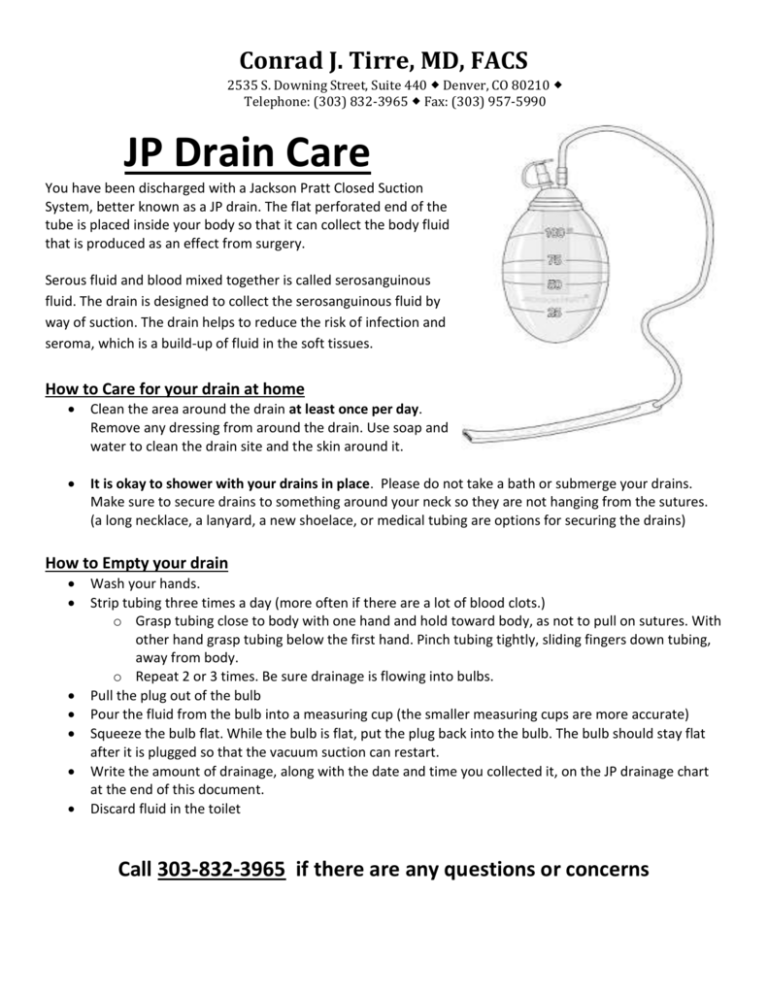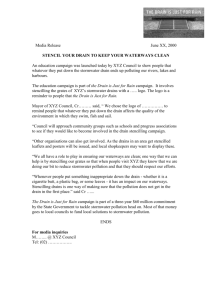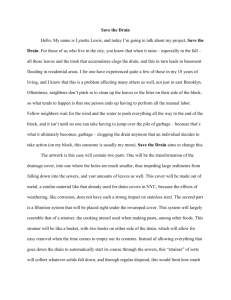JP Drain Care Instructions for Dr Conrad Tirre
advertisement

Conrad J. Tirre, MD, FACS 2535 S. Downing Street, Suite 440 Denver, CO 80210 Telephone: (303) 832-3965 Fax: (303) 957-5990 JP Drain Care You have been discharged with a Jackson Pratt Closed Suction System, better known as a JP drain. The flat perforated end of the tube is placed inside your body so that it can collect the body fluid that is produced as an effect from surgery. Serous fluid and blood mixed together is called serosanguinous fluid. The drain is designed to collect the serosanguinous fluid by way of suction. The drain helps to reduce the risk of infection and seroma, which is a build-up of fluid in the soft tissues. How to Care for your drain at home Clean the area around the drain at least once per day. Remove any dressing from around the drain. Use soap and water to clean the drain site and the skin around it. It is okay to shower with your drains in place. Please do not take a bath or submerge your drains. Make sure to secure drains to something around your neck so they are not hanging from the sutures. (a long necklace, a lanyard, a new shoelace, or medical tubing are options for securing the drains) How to Empty your drain Wash your hands. Strip tubing three times a day (more often if there are a lot of blood clots.) o Grasp tubing close to body with one hand and hold toward body, as not to pull on sutures. With other hand grasp tubing below the first hand. Pinch tubing tightly, sliding fingers down tubing, away from body. o Repeat 2 or 3 times. Be sure drainage is flowing into bulbs. Pull the plug out of the bulb Pour the fluid from the bulb into a measuring cup (the smaller measuring cups are more accurate) Squeeze the bulb flat. While the bulb is flat, put the plug back into the bulb. The bulb should stay flat after it is plugged so that the vacuum suction can restart. Write the amount of drainage, along with the date and time you collected it, on the JP drainage chart at the end of this document. Discard fluid in the toilet Call 303-832-3965 if there are any questions or concerns Conrad J. Tirre, MD, FACS 2535 S. Downing Street, Suite 440 Denver, CO 80210 Telephone: (303) 832-3965 Fax: (303) 957-5990 Jackson-Pratt Drain The Jackson-Pratt (JP) drain is a special tube that prevents body fluid from collecting near the site of your surgery. The drain helps to reduce the risk of infection and seroma, which is a build-up of fluid in the soft tissues. The drain pulls this fluid (by suction) into a bulb. The bulb can then be emptied and the fluid inside measured. Serous fluid and blood mixed together is called serosanguinous fluid. At first, this fluid is bloody. Then, as your wound heals, the fluid changes to light pink, light yellow, or clear. The drain will stay in place until less than 30 cc (about 2 tablespoons) of fluid can be collected in a 24-hour period, for two or more consecutive days. Caring for the JP drain is easy. Depending on how much fluid drains from your surgical site, you will need to empty the bulb every 4 to 6 hours. Before you are discharged from the hospital, your nurse will show you how to: empty the collection bulb record the amount of fluid collected strip the tubing to ensure patency squeeze the bulb flat and plug so that the suction works again keep the drain site clean and free of infection Complications -Sometimes, a large amount of fluid may leak from around the drain site, making the gauze dressing completely wet. If this happens, use soap and water to clean the area. Verify that the bulb drain is secured and “flat” to provide the needed suction. -Another potential side effect is the development of a clot within the drain. This appears as a dark, stringy lining. It could prevent the drainage from flowing through the tube. In this case, strip tubing several times to try to work the clot toward the bulb, and make sure to continue suction (flattened bulb) Call Dr. Tirre’s office to report either of these issues if they cannot be resolved. 309-832-3965 How to check for infection Watch the skin around the drain for these signs of infection: -increased redness -increased pain -increased swelling -fever greater than 101 ºF -cloudy yellow, tan, or foul-smelling drainage Report any of these symptoms to your doctor as soon as possible. If you have questions, please call for patient care at 303-832-3965 Conrad J. Tirre, MD, FACS 2535 S. Downing Street, Suite 440 Denver, CO 80210 Telephone: (303) 832-3965 Fax: (303) 957-5990 EXAMPLE Date: 1/2/16 Drain #1 Drain #2 Drain #3 Drain #4 Drain #5 Time: 8:00 10 3 1:00 20 25 7:00 15 10 Total 45 38 Date Drain #1 Drain #2 Drain #3 Drain #4 Drain #5 Drain #1 Drain #2 Drain #3 Drain #4 Drain #5 Drain #1 Drain #2 Drain #3 Drain #4 Drain #5 Time: Total Date Time: Total Date Time: Total www.ConradTirreMD.com www.ColoradoHandSurgery.com Conrad J. Tirre, MD, FACS 2535 S. Downing Street, Suite 440 Denver, CO 80210 Telephone: (303) 832-3965 Fax: (303) 957-5990 Date Drain #1 Drain #2 Drain #3 Drain #4 Drain #5 Drain #1 Drain #2 Drain #3 Drain #4 Drain #5 Drain #1 Drain #2 Drain #3 Drain #4 Drain #5 Drain #1 Drain #2 Drain #3 Drain #4 Drain #5 Time: Total Date Time: Total Date Time: Total Date Time: Total www.ConradTirreMD.com www.ColoradoHandSurgery.com Conrad J. Tirre, MD, FACS 2535 S. Downing Street, Suite 440 Denver, CO 80210 Telephone: (303) 832-3965 Fax: (303) 957-5990 Date Drain #1 Drain #2 Drain #3 Drain #4 Drain #5 Drain #1 Drain #2 Drain #3 Drain #4 Drain #5 Drain #1 Drain #2 Drain #3 Drain #4 Drain #5 Drain #1 Drain #2 Drain #3 Drain #4 Drain #5 Time: Total Date Time: Total Date Time: Total Date Time: Total www.ConradTirreMD.com www.ColoradoHandSurgery.com



